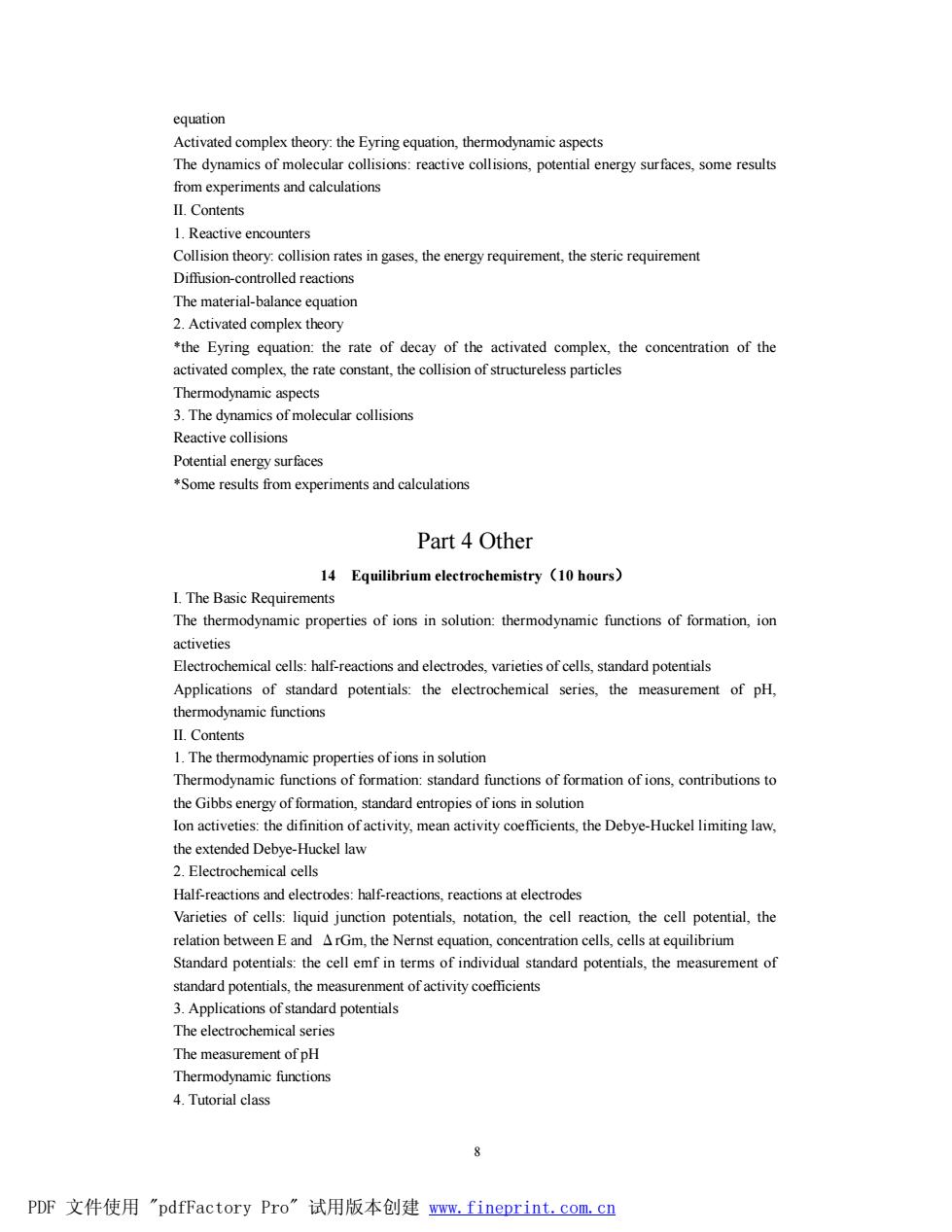正在加载图片...

The dynamics of molecuar collisions:reactive collisions,potential energy surfaces,some result from experiments and calculations II.Contents 1.Reactive encounters h然the enrgyqurmnl the一 The material-balance equation 2.Activated complex theory *the Eyring equation:the rate of decay of the activated complex,the concentration of the activated complex the rate constant,the collision of structureless particles Thermodynam ects Reactive collisions Potential energy surfaces *Some results from experiments and calculations Part 4 Other 14 Equilibrium electrochemistry (10 hours) I.The Basic Requirements The thermodynamic properties of ions in solution:thermodynamic functions of formation,ion aiocinaleaeosadoioamsacahodpoi场 Applications of standard potentials:the electrochemical series,the measurement of pH, thermodynamic functions II Contents ropertiesofionsinsoluion The odynamic functio the Gibbs energy,standa rd entropies of ions in solutior lon activeties:the difinition of activity,mean activity coefficients,the Debye-Huckel limiting law. the extended Debye-Huckel law 2.Electrochemical cells and:half-reaction reactions at Varieties of cels:liquid junctio,the the cell potential,the relation between E and ArGm,the Nernst equation,concentration cells,cells at equilibrium Standard potentials:the cell emf in terms of individual standard potentials,the measurement of standard potentials,the measurenment of activity coefficients 3 Applications of standard potentials The electr hemical series The measurement of pH Thermodynamic functions 4.Tutorial class PDF文件使用"pdfFactory Pro”试用版本创建n,fineprint,com,cn 8 equation Activated complex theory: the Eyring equation, thermodynamic aspects The dynamics of molecular collisions: reactive collisions, potential energy surfaces, some results from experiments and calculations II. Contents 1. Reactive encounters Collision theory: collision rates in gases, the energy requirement, the steric requirement Diffusion-controlled reactions The material-balance equation 2. Activated complex theory *the Eyring equation: the rate of decay of the activated complex, the concentration of the activated complex, the rate constant, the collision of structureless particles Thermodynamic aspects 3. The dynamics of molecular collisions Reactive collisions Potential energy surfaces *Some results from experiments and calculations Part 4 Other 14 Equilibrium electrochemistry(10 hours) I. The Basic Requirements The thermodynamic properties of ions in solution: thermodynamic functions of formation, ion activeties Electrochemical cells: half-reactions and electrodes, varieties of cells, standard potentials Applications of standard potentials: the electrochemical series, the measurement of pH, thermodynamic functions II. Contents 1. The thermodynamic properties of ions in solution Thermodynamic functions of formation: standard functions of formation of ions, contributions to the Gibbs energy of formation, standard entropies of ions in solution Ion activeties: the difinition of activity, mean activity coefficients, the Debye-Huckel limiting law, the extended Debye-Huckel law 2. Electrochemical cells Half-reactions and electrodes: half-reactions, reactions at electrodes Varieties of cells: liquid junction potentials, notation, the cell reaction, the cell potential, the relation between E and ΔrGm, the Nernst equation, concentration cells, cells at equilibrium Standard potentials: the cell emf in terms of individual standard potentials, the measurement of standard potentials, the measurenment of activity coefficients 3. Applications of standard potentials The electrochemical series The measurement of pH Thermodynamic functions 4. Tutorial class PDF 文件使用 "pdfFactory Pro" 试用版本创建 www.fineprint.com.cn